Escaping to the Valley of the Gods in the Jeep Wrangler 392
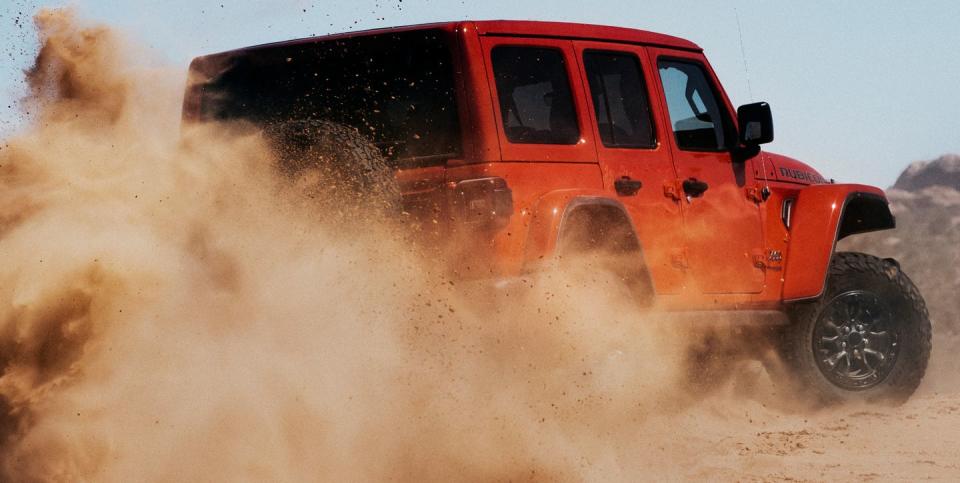
Sometimes you don't realize how goddamn nuts you’ve gone until you see how other people react to you. Among the soaring and tumbling prehistoric rock formations of remote Utah, a sweet young couple happened upon me in a moment of turmoil. I’d rambled up a rocky track off the Burr Trail in a filthy red 2021 Jeep Wrangler Rubicon 392. I was hungry.
It was a short hike to the promontory of Spike Valley, between Hanksville and Boulder, Utah, overlooking Capitol Reef National Park. The couple was from Wisconsin, and they were kitted out in responsible hiking gear, with Nalgene water bottles and walking sticks. The track was rocky enough that they’d parked their Dodge camper conversion a few miles back.
This story originally appeared in Volume 6 of Road & Track.
SIGN UP FOR THE TRACK CLUB BY R&T FOR MORE EXCLUSIVE STORIES
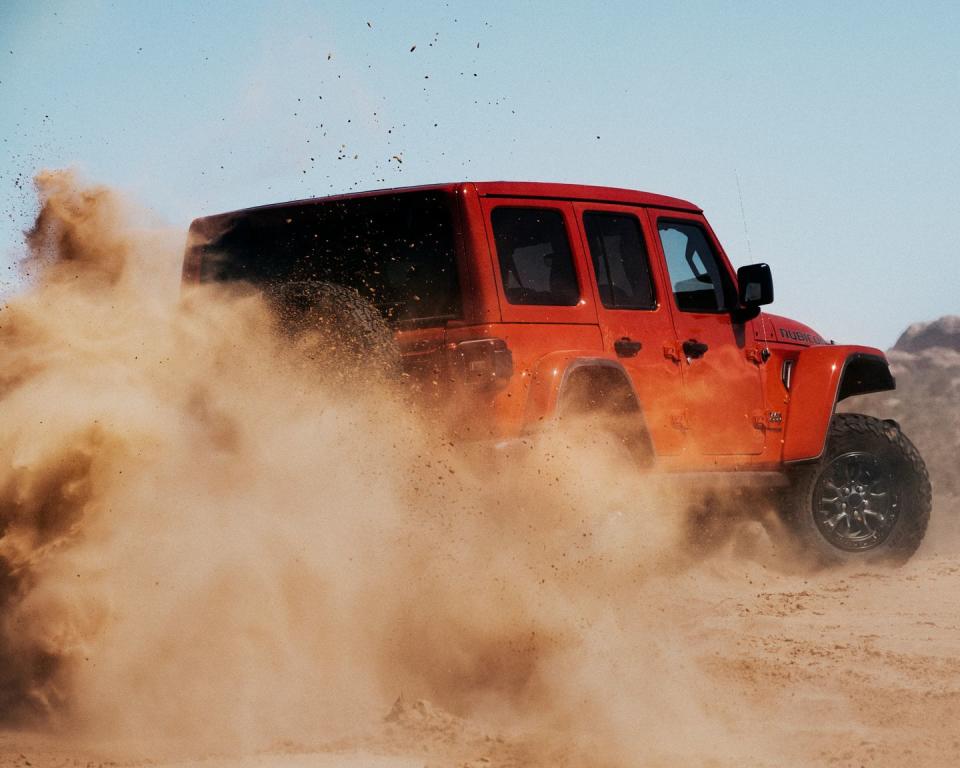
After our encounter, I imagined what they saw when they came across me: wild hair over a slick, sunburned forehead, dirty black jeans with a rip in the crotch, doofy Ray-Bans with a Captain America logo in the middle of the frame. I was trying to mix a new container of organic peanut butter, and peanut oil was everywhere.
We had a nice chat there next to the Wrangler. He’s a first responder, she’s a school administrator. We talked about the coronavirus back in New York City, where I’m from. Within minutes, I heard myself speaking at a fast clip about some of the things I had witnessed in NYC over the past year: the blare of ambulance sirens, empty streets, wealthy flight to the countryside, schools shut down, panic in the supermarket aisles.
As the pair tried to break off from the conversation and continue down the trail, I launched into a story of bicycling with my kids in mid-April, when the city’s daily death toll reached 1000. My kids weren’t wearing masks. At the time, nobody knew much about the virus, but we were outside, and I made a judgment call. A guy in a ponytail wearing a fancy respirator and walking a little poodle crossed the street and yelled something at me.
“You’re a danger to us all,” he said.
“What?”
“I hope your children die.”
It was a bracing moment, I told them. I sat down on the sidewalk, and my oldest daughter, who is 8, looked at me and said, “He seems very scared. I feel bad for him.”
The couple from Wisconsin didn’t say much. “Maybe we’ll see you up there,” he said, with a compassion in his voice that made me uncomfortable. I realized that I’d become an object of pity. “Take care of yourself.”
Why am I telling you this? This is a car magazine, after all. At first glance, this is a story about driving a V-8-powered Jeep Wrangler down through the Grand Staircase-Escalante National Monument, some of the most remote territory in the U.S. I would test the new engine against some difficult terrain—does the V-8 carry too much weight on the tough stuff?—and then, after the requisite mishaps, I would land at Amangiri, a mythically excellent hotel that serves the best breakfast in the world.
But the story is really about me, nearly a year to the day when I felt my first symptom of COVID (I had a mild case), escaping the madness that is America and trying to put everything behind me: to get lost. When the first emotional spike of actually detaching from the past year hit me, it was in front of that poor couple. A day into my trip, leaning on the open tailgate of this 470-hp, $73,000 bright red 2021 Jeep, I was having a moment.
It’s been a hell of a year. I can say that. So can you. Like me, you had an instant when your blood went cold as you thought about your child or another loved one suffering from a “novel” coronavirus. You experienced the dread in March 2020 when you waved to your colleague from across an office and said, with a heart full of doubt: “Weird times, bro. See you in a couple of weeks.”
And then the months passed. You stopped worrying about your children getting the virus, and instead wondered if they would ever remember a time when they didn’t have to wear masks in public, when they could see their teachers smile, smell the chalk dust and pencil erasers in their classrooms.
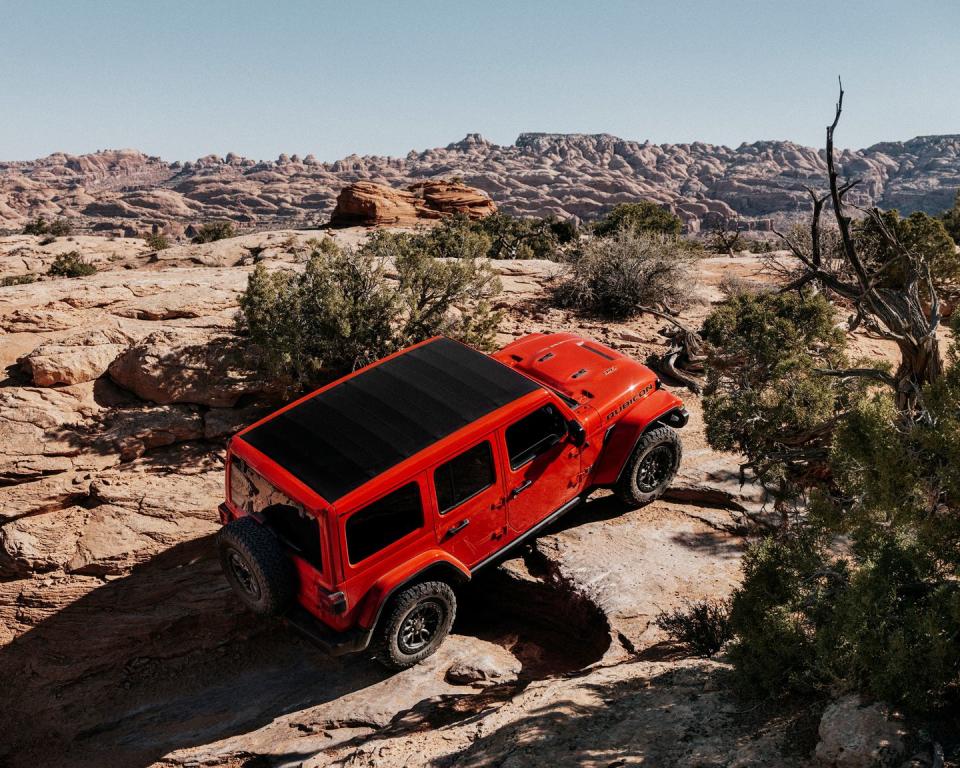
You watched the news. You buried yourself in your phone. You bathed in the malice of the public forum—the same malice that made people wish, through five masks, ill of your kids. The solace you sought in the protection of your home became isolation. You watched TV, placed bids on Bring a Trailer. You sought boredom and couldn’t escape the monotony of anxiety.
And that’s why I’m here. I needed to put the year behind me, the time spent existing in Brooklyn, the heart of the pandemic. I wanted a place so quiet I could simultaneously hear a jet flying 40,000 feet above and listen to my heartbeat.
I’m driving southwest, through Boulder, Utah, then on to the town of Escalante and into the Grand Staircase. My first campsite will be just past Escalante. I’m going to camp in a tent and cook food on a fire.
The switchbacks await. It’s warm enough to open the ragtop. The Jeep’s 6.4-liter V-8 echoes across the canyon. With each turn, I steer into a cloud of my own dust. The Wrangler hops like an athlete warming up for the 100-meter.
I decide to take a right on Canyon Road, about 15 miles outside of Escalante. I have no idea what the road is like, only that it leads in the right general direction. And it’s on the map—BLM (Bureau of Land Management) Road 340. I’d asked some locals in Escalante about it and they shrugged. Don’t know it; can’t vouch for it. But it goes where I’m going: What could possibly go wrong?
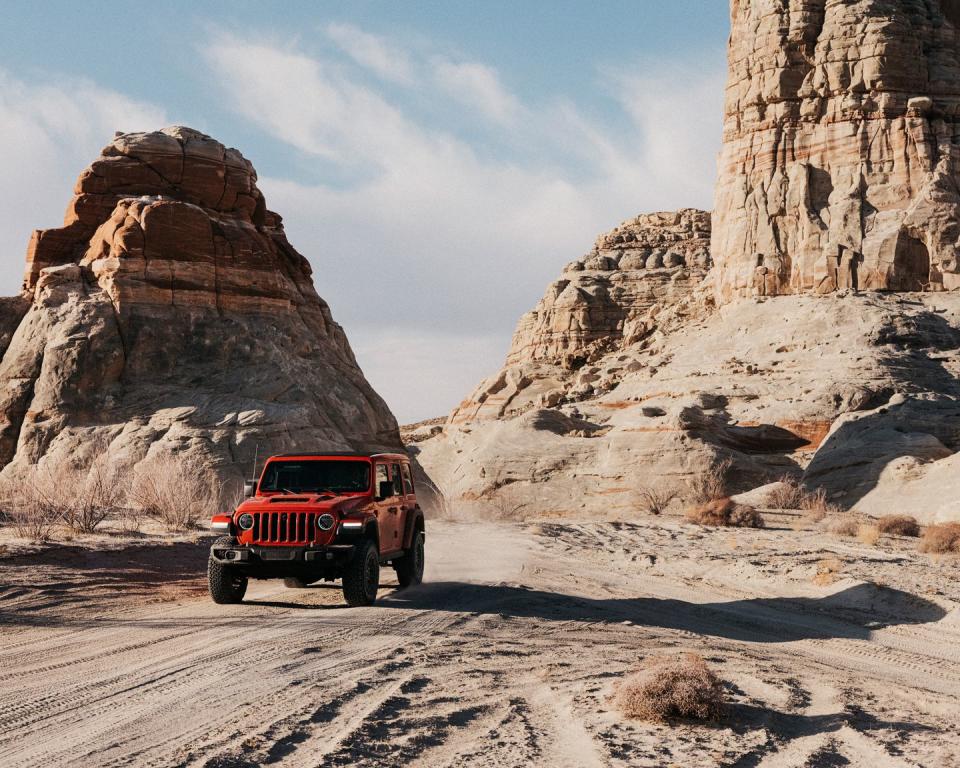
Define wrong. On BLM 340, I most definitely reach and breach the limit of my off-roading talents. The road I stumble upon is steep, wrecked in two places by spring rockslides, and technical. It’s an accidental discovery. Nearly impassable, it is one of the most spectacular and untouched tracks through Utah—accessible in the spring only by the most robust off-roaders. This Wrangler, with its heavy V-8, carries me with brakes locked down some vertiginous cliffside grades. But its angles of approach, departure, and breakover are just aggro enough.
After just a mile, the desert terrain turns into rock, gravel, mud, and jagged slab. There are sections with moving water. The canyon winds are picking up and the sun, still low in the sky, isn’t hitting the canyon floor. I stop for a snack of sardines, apple slices, and peanut butter. I’m starting to feel a little nervous about the weather, having nearly frozen in a sleeping bag the night before.
Fuck it, I can always sleep in the Jeep.
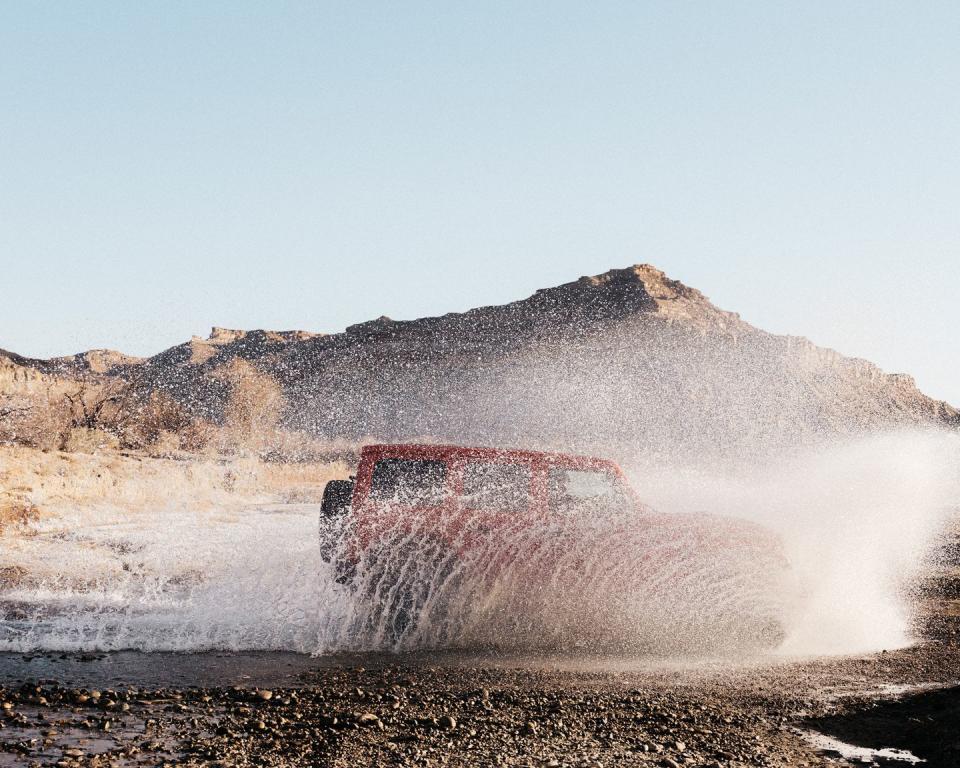
As I dig into the sardines, I look up and see a coyote walking along the rim. It gazes down, unafraid. The early spring snowmelt has brought the mud, which I suppose keeps out the tourists. I spend two hours climbing over protruding rocks in 4-High, and I haven’t seen any other people. In fact, there aren’t any other truck tracks. Is that a good sign?
As I wheel up through the canyon toward the Kaiparowits Plateau, I think about the year I just went through. COVID. My mother’s cancer diagnosis. My 41-year-old brother’s sudden and severe heart attack. It happened right after Thanksgiving. It almost killed him. We spoke that night and he talked about the ambulance ride to Poughkeepsie. Right before they put a catheter in his arm, doctors racing the clock, one leaned toward him with a release form and said, “The worst thing that will happen in your life could happen right now. Sign this.”
What’s the worst thing that could happen in my life right now? Pretty small stuff. I’m slightly worried that nobody else has tried this trail, but the Rubicon is a robust beast. I suppose I could run out of gas, though that’s unlikely, and I have a 10-gallon jerrican. I could easily puncture a tire on one of the spiky rocks in the slide piles along the trail. If I take a quick walk into one of the countless slots in the canyon walls, a rock could fall and pin my arm, like what happened to Aron Ralston in Bryce Canyon, 150 miles to the northeast. I don’t have a cell signal.
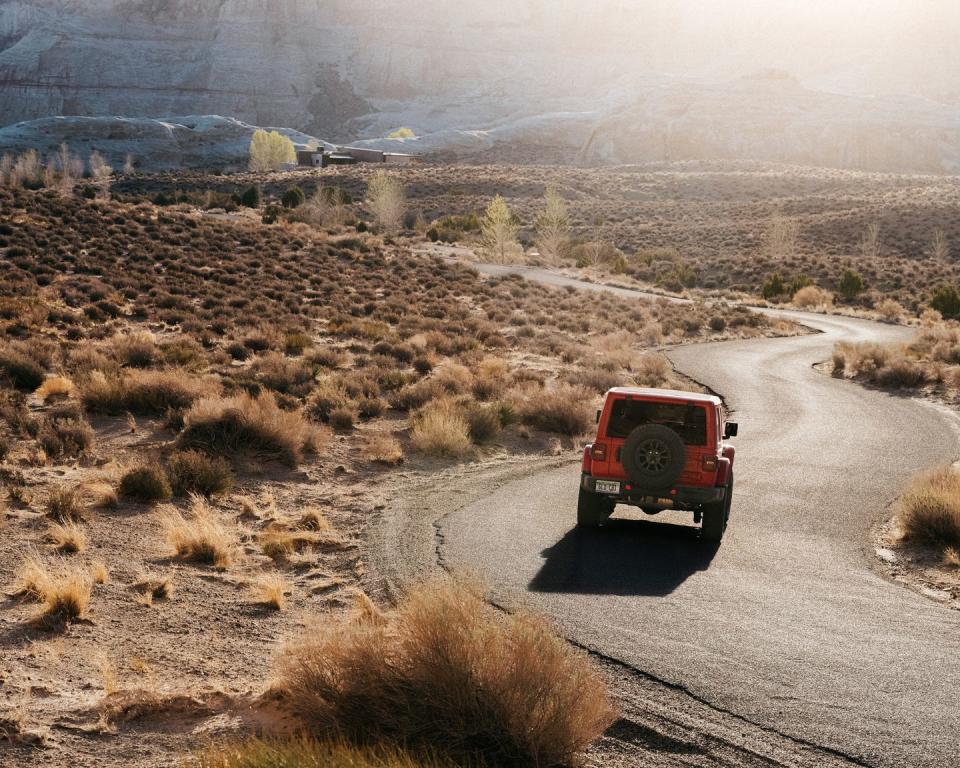
But if I can walk, it’s an easy 15-mile trek back to the washboard road and the Mormon traffic jam. The central tenet of off-roading is trusting your vehicle. The Jeep ethos, which comes from the first Willys in World War II, is that it can actually deliver you safely to your destination. That’s what the customers demand. And for the most part, the Wrangler Unlimited Rubicon 392 delivers. It’s the real deal.
After I climb the 2000 feet to the top of the rim, the canyon guiding BLM 340 opens up into a vast promontory of scrub brush—sage and lavender and sand as far as I can see. The rugged, slow plod turns into a perfectly pleasant drive. The road is evenly graded. I’ve made it to the top of the mountain range, to the rim. I get a hint of cell signal and a 360-degree view of a high plateau. It’s a mind-melting expanse. The proportion of human to landmass is so skewed that my New England brain, accustomed to narrow colonial lanes and modest foothills, can’t quite process the equation. For the first time in my adult life, I yell out “HELLO!” and wait for the echo. And wait.
Fun piece of geological history: Utah was once the Pacific coast of North America. It was a while ago (about 300 million years back, in the Paleozoic Era, when beasts emerged from the ocean and roamed a supercontinent called Pangaea). The Grand Staircase itself is named for the descending layers of rock revealed during the tectonic upheavals over the past 500 or so millennia. When I reach the top of the Kaiparowits Plateau, I’m on the Pink Cliffs, made of a combination of limestone, sandstone, and tropic shale. As I kick the Wrangler into 4-Low, and engine-brake down the busted-up road toward Lake Powell in the east, I’ll cross the Gray Cliffs, the White Cliffs, and the Vermilion Cliffs. If I continued south to the Grand Canyon, I’d eventually come to the Chocolate Cliffs.
Meanwhile, the road is a mess. The winter ice and snow unsettled the local formations, and rockslides and wash have broken the road. Twice I have to stop, fill in a hole with large rocks, and improvise a bridge with some Maxx Traxx. On a couple of 20- to 22-degree downgrades, the weight of the big V-8 overwhelms the balance of the Jeep, and I slide. Not a fun feeling when you’re negotiating a turn on an off-camber road cut into a 100-foot vertical slope.
After a few hours, I level out in the Navajo Sandstone of the White Cliffs, which are ocher, and dusted with 400-million-year-old salt, a remnant of the era when ocean waves lapped the coast of Utah. On reflection, this was some of the most intense driving I’ve ever done. The roads are borderline impassable. It’s exactly what I was looking for when I came here.
The sandstone canyons give way to Glen Canyon National Recreation Area and the shores of Lake Powell, a man-made body of water formed when the U.S. Bureau of Reclamation dammed the Colorado River in the Fifties and Sixties. After the dam was completed in 1966, it took four years for Glen Canyon to capture enough water to generate hydroelectric power, and more than 17 years to fill up to its maintenance volume of 9 trillion gallons (making it the second-largest man-made reservoir in the United States after Lake Mead, on the other side of the Grand Canyon).
One final canyon road leads to Warm Creek Bay. I need to set up camp and eat a pouch of dehydrated chicken paella. But as I carefully cross the dry lakebed shores to some appealing-looking dunes, I see three trucks parked by the water. They are waving at me. Uh-oh. I park and walk to them.
All three vehicles have buried their tires in the lakebed muck lurking just beneath the sunbaked crust. There’s a Dodge van with a couple traveling musicians who have decked out the interior with a kitchen and bedroom, a mandolin collection, and a massive plastic bin full of weed. The rig must weigh 12,000 pounds, and the chassis is hung up on the crust. A first-gen Tacoma with a California couple drove over to rescue them and promptly got stuck. Then a GMC Acadia arrived and planted itself.
I approach carefully with the Wrangler and pull them out one by one using 100 feet of nylon webbing and the tow hook on the Rubicon’s steel bumper. One guy offers me money.
“Are you kidding?” I say. “I should pay you.” The folks in all three cars are just rambling around the country, with no particular destination, no hurry. They were stuck in the peanut-buttery muck, but they weren’t running from or hurrying toward anything.
I set up camp in the disappearing dusk, as the bats come out and swallow up the dune flies and mosquitoes. I can see the lights of Page, Arizona, across Lake Powell. Everything is as it should be.
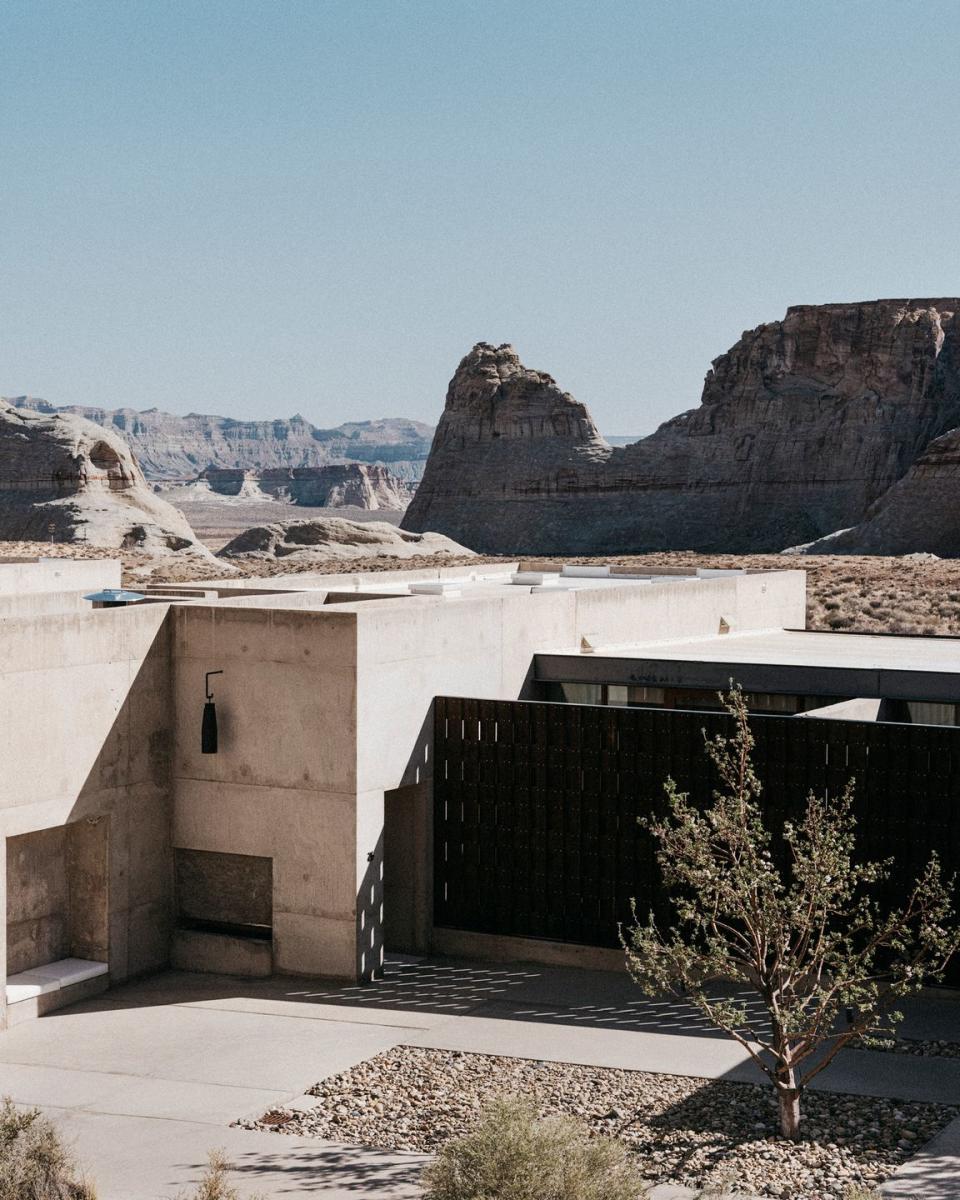
Amangiri is a golden oasis. Now onto the real reason I took this trip: huevos rancheros. But not just any huevos rancheros. These are the best in the United States, if not North America. I don’t even know how much they cost. They are served at Amangiri, a hotel so special that to know it is to pause, and whisper, “That place . . .” I’ve been here before, during a product launch of a Range Rover in 2012. It’s a magical hideaway, silent and spooky, with a pool that wraps around a 165-million-year-old limestone formation. Lawmakers had to pass an act of Congress to allow the owners to build the pool. Worth it. Every angle of Amangiri is considered, and the thoughtfulness reflects or contrasts the vast formations of the Staircase with a stark yet embracing precision.
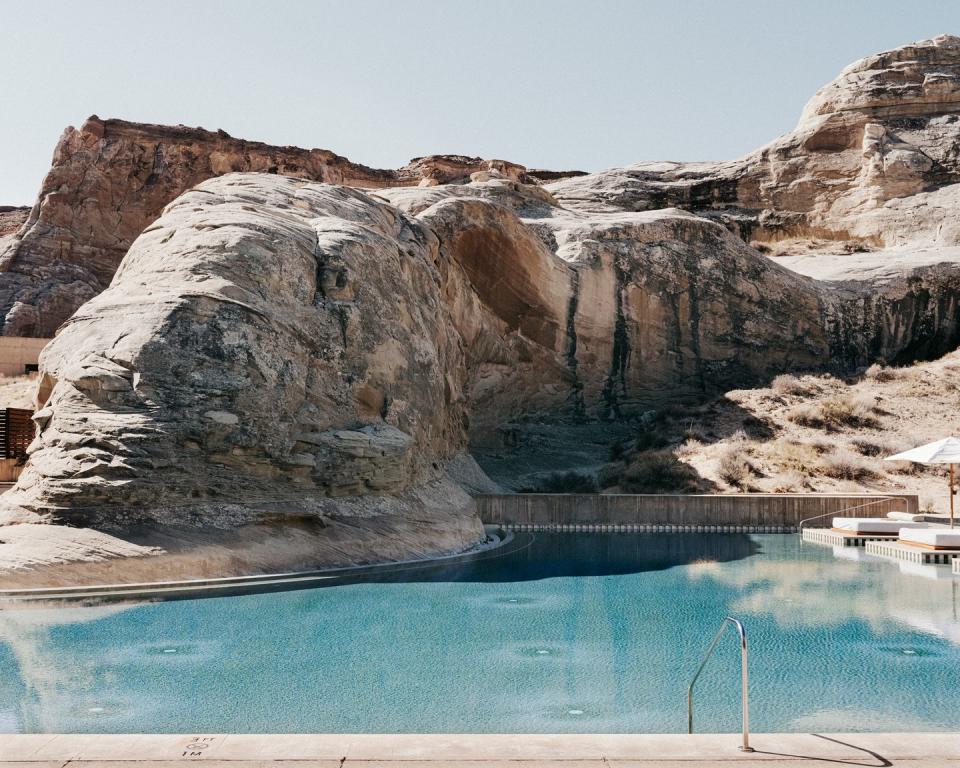
For a decade I’ve thought about Amangiri’s huevos rancheros. The waitress approaches me. I’m filthy from camping. Happily, I order the huevos. When they arrive, I feel emotional: two fried eggs lowered upon a tostada, lowered upon a layer of beans, then another tostada, then ground chorizo. Crumbled cheese and diced chilies and onions sprinkled on top. Finally, sprigs of green onion rise from it all like a proud flag. My breakdown at Spike Valley, in front of those two Wisconsinites, feels distant. The Jeep did everything I asked of it. I discovered a lost trail, and I got a little lost myself.
The past year, with all of its horrors, can be put in its place. The vaccine has arrived. The eggs are a triumph. Life goes on.
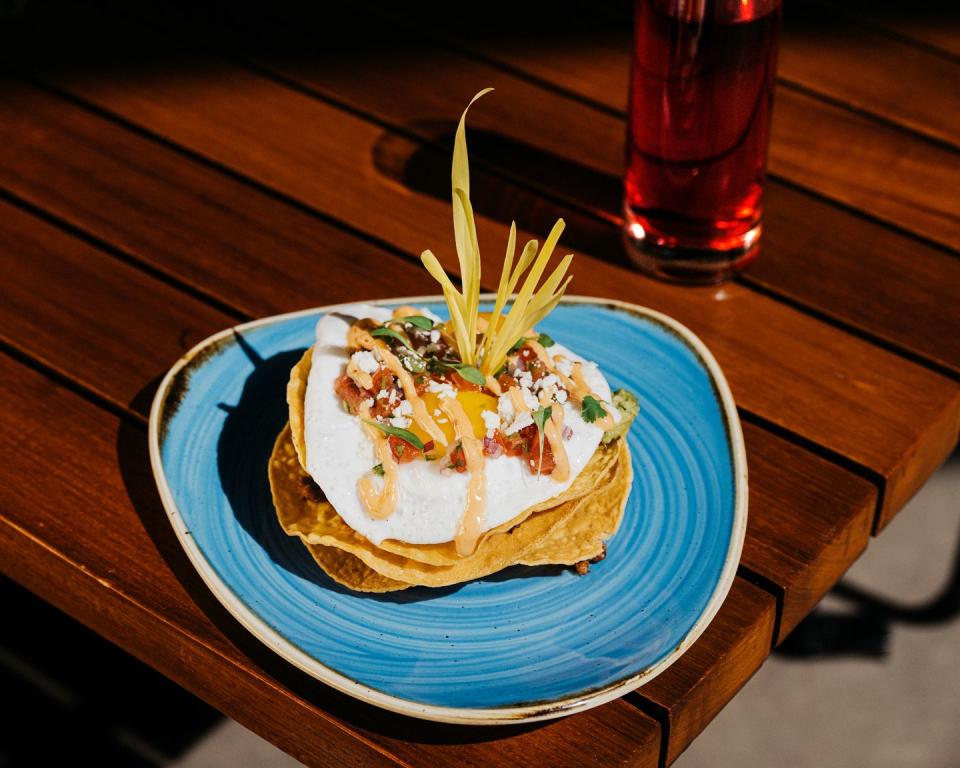
SIGN UP FOR THE TRACK CLUB BY R&T FOR MORE EXCLUSIVE STORIES
You Might Also Like

 Yahoo Autos
Yahoo Autos 